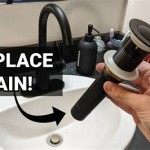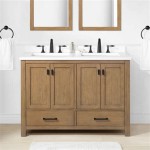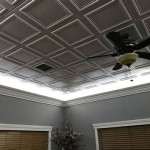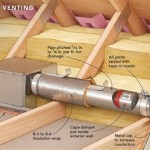Bathroom Sink Drain With Plug: A Comprehensive Guide
Bathroom sink drains with plugs are essential components of any bathroom, providing a simple and efficient way to control water flow and maintain hygiene. The drain mechanism, typically featuring a pop-up stopper, allows users to fill the sink for tasks like washing hands, shaving, or cleaning, and then drain the water when finished. This article will explore the mechanics, types, and maintenance considerations of bathroom sink drains with plugs.
Understanding the Mechanics
A bathroom sink drain with a plug consists of several key parts:
- Drain Body: This is the main component that connects the sink to the plumbing system. It typically features a threaded opening at the bottom for attaching the drain pipe.
- Pop-Up Stopper: The primary function of the pop-up stopper is to control water flow. This stopper is attached to a lift rod that extends up through the overflow drain hole in the sink bowl.
- Lift Rod: This is a metal rod that connects the pop-up stopper to the drain knob. It is typically made of brass or chrome and can be adjusted in length to align with the sink's design.
- Drain Knob: This is the visible part of the drain system that is used to control water flow. It is attached to the lift rod and is typically made of metal or plastic. When the knob is pushed down, the pop-up stopper rises to block the drain hole. When the knob is lifted, the stopper drops down, allowing water to flow through the drain.
- Overflow Drain: This is a secondary drain located above the main drain hole. It acts as a safety feature to prevent water from overflowing the sink if the main drain becomes blocked.
- Drain Pipe: This pipe connects the drain body to the plumbing system and carries wastewater away from the sink.
The pop-up stopper can be made from various materials such as rubber, plastic, or metal. It is typically designed to create a tight seal against the drain hole when engaged, preventing water from escaping. The drain knob can be designed in different styles and finishes, from classic round designs to more contemporary square or rectangular shapes.
Types of Bathroom Sink Drains with Plugs:
There are several different types of bathroom sink drains with plugs available, each with its own advantages and disadvantages.
1. Traditional Pop-Up Drain:
These are the standard and most common type of bathroom sink drain. They feature a pop-up stopper that is lifted or lowered by a drain knob. These drains are simple, affordable, and readily available. However, they can sometimes be prone to clogging or leaking, especially if the pop-up stopper or lift rod becomes worn or damaged.
2. Push-and-Pull Drain:
These drains function similarly to traditional pop-up drains, but they use a push-and-pull mechanism instead of a knob. The stopper is lifted or lowered by pushing or pulling on the drain itself. This type of drain is often seen in contemporary bathroom designs and is considered to be more aesthetically pleasing as it eliminates the need for a separate drain knob.
3. Basket Strainer:
Basket strainer drains are designed with a removable basket that sits over the drain hole. This basket acts as a strainer, catching hair, soap scum, and other debris before it can clog the drain. Basket strainer drains are very effective in preventing clogs. However, the removal of the basket for cleaning can be inconvenient.
4. Push-to-Close Drain:
As the name suggests, these drains have a stopper that is pushed down to close the drain. This type of drain is often found in commercial restrooms and is designed to be easy to use, even with wet hands.
Maintenance and Troubleshooting
Proper maintenance is essential for ensuring the longevity and functionality of your bathroom sink drain with plug. Here are some key considerations:
1. Regular Cleaning:
Hair, soap scum, and other debris can accumulate in the drain, leading to clogs. Regularly cleaning the drain with a drain cleaner or a mixture of baking soda and vinegar can help prevent clogs. It is especially important to remove the pop-up stopper and clean it periodically as well.
2. Inspecting the Lift Rod:
The lift rod can become bent or damaged over time, affecting the proper functioning of the drain. It is important to inspect the lift rod periodically and replace it if necessary.
3. Replacing Worn-Out Parts:
The pop-up stopper, drain knob, and other parts of the drain system can wear out or become damaged over time. If any of these parts are showing signs of wear or damage, it is best to replace them immediately to prevent leaks or other problems.
4. Addressing Clogs:
If your bathroom sink drain is clogged, there are several methods you can try to clear the blockage. Simple solutions include using a plunger or a drain snake. More stubborn clogs may require professional intervention.
Understanding the mechanics, types, and maintenance requirements of bathroom sink drains with plugs can help ensure their smooth operation and prevent potential problems. Regularly cleaning and inspecting the drain can extend its lifespan and keep your bathroom functioning efficiently.

Pop Up Lift Turn Pull Out Stopper Bathroom Sink Drains

This Image To Show The Full Size Version Bathroom Sink Stopper Repair Drain

Universal Bathroom Plug 38mm Basin Drain Pop Up Sink Stopper Solid Brass Chrome

Keeney 1 4 In Push On Bathroom Sink Drain With Overflow Brushed Nickel K820 75bn The Home Depot

Universal Washbasin Water Head Leaking Stopper Bathroom Sink Drain Strainer For And Bathtub Replacement Parts Silver Com

Universal Sink Stopper Silicone Bathtub Kitchen Drain Strainer

How To Fix A Bathroom Sink Drain Stopper 4 Easy Solutions

Brass Drain Plug Bathroom Sink 66mm Polished Chrome Pop Clack For Bath Vanity Replacement Bolts Tub Fruugo No

How To Replace A Sink Stopper Quick And Simple Home Repair

The Plumber S Choice 1 5 8 In Bathroom Faucet Universal One Touch Vessel Vanity Sink Pop Up Drain Stopper Without Overflow Polished Nickel 1301r Home Depot
Related Posts







